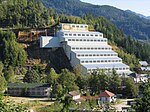Porteau Cove Provincial Park
1981 establishments in British ColumbiaIUCN Category IIProtected areas established in 1981Provincial parks of British ColumbiaSea-to-Sky Corridor ... and 1 more
Underwater diving sites in Canada

Porteau Cove Provincial Park is a provincial park located along the eastern shore of Howe Sound in British Columbia, Canada.
Excerpt from the Wikipedia article Porteau Cove Provincial Park (License: CC BY-SA 3.0, Authors, Images).Porteau Cove Provincial Park
Porteau Cove Campground Access Road, Area D (Elaho/Garibaldi)
Geographical coordinates (GPS) Address Phone number Website Nearby Places Show on map
Geographical coordinates (GPS)
| Latitude | Longitude |
|---|---|
| N 49.55716 ° | E -123.23588 ° |
Address
Porteau Cove Provincial Park Campground
Porteau Cove Campground Access Road
Area D (Elaho/Garibaldi)
British Columbia, Canada
Open on Google Maps







